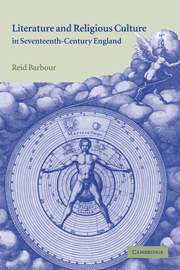Book contents
- Frontmatter
- Contents
- Acknowledgements
- Introduction: spirit and circumstance in Caroline Protestantism
- Chapter 1 The church heroic: Charles, Laud, and Little Gidding
- Chapter 2 Great Tew and the skeptical hero
- Chapter 3 Between liturgy and dreams: the church fanciful
- Chapter 4 Respecting persons
- Chapter 5 Decorum and redemption in the theater of the person
- Chapter 6 Nature (I): post-Baconian mysteries
- Chapter 7 Nature (II): church and cosmos
- Conclusion: Rome, Massachusetts, and the Caroline Protestant imagination
- Notes
- Index
Conclusion: Rome, Massachusetts, and the Caroline Protestant imagination
Published online by Cambridge University Press: 22 September 2009
- Frontmatter
- Contents
- Acknowledgements
- Introduction: spirit and circumstance in Caroline Protestantism
- Chapter 1 The church heroic: Charles, Laud, and Little Gidding
- Chapter 2 Great Tew and the skeptical hero
- Chapter 3 Between liturgy and dreams: the church fanciful
- Chapter 4 Respecting persons
- Chapter 5 Decorum and redemption in the theater of the person
- Chapter 6 Nature (I): post-Baconian mysteries
- Chapter 7 Nature (II): church and cosmos
- Conclusion: Rome, Massachusetts, and the Caroline Protestant imagination
- Notes
- Index
Summary
In his celebrations of the Church of England, Thomas Browne often draws circles. Sometimes he envisions that the faithful children of that church follow its “great wheele,” Browne's version of hunkering down behind what Laud called the hedge and George Herbert the double moat of the ecclesia anglicana. According to Browne, Laud, and Herbert alike, outside the privileged temple crouch heresy, schism, and insubordination, three enemies just waiting for an opportune gap. But as Anthony Milton has recently written of this collectively but variously imagined circle in early Stuart religious culture, the dynamic and ambiguous struggle to determine the identity of the Church of England became increasingly divisive – or at least more openly and aggressively fractious – in the 1620s and 30s, reason enough for Laud to heighten the hedge and for Herbert to double the moat. For Browne, however, the loyal child of the mother church also explores the vast space outside a circle, singularly pursuing those “many things untouch'd, unimagin'd, wherein the libertie of an honest reason may play and expatiate with security and farre without the circle of an heresie.” If the safer Church of England relegates recusants and nonconformists to the jurisdiction of circumstance – standing around orthodoxy – Browne's re-conception of the theological cosmos applauds the same church for boldly and fervidly wayfaring in that extra-circular area.
I have argued that the Caroline expatiation in the circumstances of faith accounts for the stocktaking complexity and exploratory richness of its religious discourse.
- Type
- Chapter
- Information
- Literature and Religious Culture in Seventeenth-Century England , pp. 236 - 250Publisher: Cambridge University PressPrint publication year: 2001



